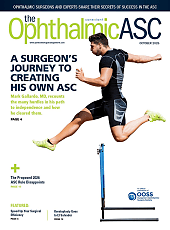The following transcript has been edited for clarity:
Dr. Feulner: Welcome to AAO 2025 in Orlando. I'm Dr. Lisa Feulner, chief medical editor for Ophthalmology Management, and I have the honor and privilege of having Dr. Brandon Ayres with me today to talk about some new and exciting technology. It's always really wonderful when we have two different technologies in our office that are made better by each other, which I don't think happens all the time. Brandon and I are big fans of the iTrace ray-tracing technology made by Tracey Technologies, and we both use it extensively in our offices to help us determine candidacy for different types of lenses.
We use it for postoperative evaluation and we use it a lot with another common technology that Dr. Ayres and I enjoy using, and that is the Apthera IC-8 small-aperture lens (Bausch + Lomb). Brandon, tell me about how you use the iTrace in your office preoperatively, how it helps to determine which patients are candidates for which types of lenses, and then whether it helps you with your postoperative evaluation and ultimately how that technology helps you determine whether the IC-8 is a good choice for a patient and how you use it to evaluate your outcomes with this lens, which can be challenging to determine refractive outcomes afterwards.
Dr. Ayres: Sure. So for me, I'll admit that I am relatively new to the iTrace world. So we've had an iTrace now in a single office. We have a few offices, and I tell you I really miss it in the offices where I don't have it. And I'm sure as we update technology, they'll all turn into iTraces. There's so much data in the iTrace, it can be a little bit daunting at first. So if you haven't used an iTrace, just give it a minute and you'll quickly learn to love it. I say it's my Swiss Army knife of anterior-segment disease.
Dr. Feulner: Good description.
Dr. Ayres: So we screen almost every patient with the iTrace, whether I think they're a candidate for an AP lens or a standard lens or a multifocal.
Dr. Feulner: Or a toric; they’re a great tool for a toric.
Dr. Ayres: In one device, you have your aberrometry, you've got a Placido disc, you've got dry eye testing, you've got autorefractions. You can manipulate the data so many ways and you can do it in front of the patient. And so it's also a great educational tool. And we will point to the screen and we'll say, look, this is what it shows from your cornea, and here's what it shows from the lens. It thinks your cataract is the issue. And we'll look at the Placido rings and see if something like a keratectomy is going to be necessary. Do they have a lot of astigmatism or are they a toric candidate? And in the irregular patient or in the standard patient looking for monovision, we can sort of cone down, if you will, the effect of pupil size. And take for example, a keratoconus patient or maybe a radial keratotomy patient where they have some irregularity. We can shrink the effective pupil size down and watch the image quality improve on the screen, which helps me confirm that a small-aperture lens may be an appropriate implant for a patient with a slightly irregular cornea. Now, if they have a regular cornea, still a great monovision lens, and it helps us screen for those. And once in a while we'll catch a patient who has just a high level of irregularity, but an irregular cornea, not a diseased cornea.
Dr. Feulner: Do you mean higher order aberrations?
Dr. Ayres: Right. So that might not be a great candidate for a trifocal or a diffractive lens, but they still may be a good candidate or even better candidate for a small-aperture lens.
Dr. Feulner: I agree with you. I find that I think there's a big population of patients who want presbyopic lenses and are afraid because they may be not tolerant to the potential dysphotopias or they have higher order aberrations and they're just not a great candidate for a good outcome. And I think being able to see what their effective vision might be with a small pupil adjustment in the iTrace is a great technology to help us evaluate which patients are good patients for that Apthera lens. And even the technology allows us to show patients what their vision would be if their astigmatism is corrected, and then we can show them a simulated way, what their vision would be like with toric or astigmatic correction after surgery.
Dr. Ayres: So what I love about the iTrace is it gives us the tools and the technology and the teaching ability to take every single patient that comes into the office and make them a premium lens candidate.
Dr. Feulner: Any other comments or suggestions that you might have?
Dr. Ayres: If you're looking for a new abberometer or a Placido disc-based topographer, the iTrace has everything in one.
Dr. Feulner: Thank you. Appreciate your time today.
Dr. Ayres: No problem. Thank you.








